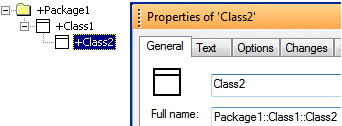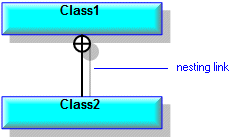Overview of nested classes (includes data types, interfaces and signals)
Classes, Data Types, Interfaces and Signals can own (nest) other Classes, Data Types, Interface, Signals as follows:
• A Class can own other Classes, Data Types, Interfaces and Signals.
• A Data Type cannot own other Data Types, Classes, Interfaces or Signals.
• An Interface can own other Interfaces, Classes, Data Types and Signals.
• A Signal can own other Signals and Classes.
In addition, the Packages pane shows Class, Data Type, Interface and Signal ownership and you can change the Class, Data Type, Interface and Signal hierarchy through drag-and-drop operations.

The Full Name of a nested Class, Data Type, Interface or Signal includes the names of scoping Packages, Classes, Data Types, Interfaces and Signals. Parent Packages, Classes, Data Types, Interfaces and Signals are delimited by double colons.

On a Class Diagram, Class, Data Type, Interface and Signal ownership can be shown through Nesting Links.

Note that Nesting Links can also show ownership relating to Packages, Use Cases and Activities.
On a Class Diagram you can populate missing Nesting Links by right-clicking the diagram background, pointing to Populate, and then clicking Item Nesting.
You can hide or show the full name of a Class, Data Type, Interface or Signal on a Class Diagram through its View Options.
When you delete a Class, Interface or Signal, you delete any child Classes, Data Types, Interfaces and Signals, and other owned items.
• When you delete a Nesting Link from a Class Diagram, you can use the Delete or Delete From Model command: ◦ Delete removes the link from the diagram, but does not change item ownership. ◦ Delete From Model removes the link from the diagram and then scopes the nested item to the Model. • You can right-click a Class, Interface or Signal in a Modeler pane, point to New, and then click Class, Data Type, Interface or Signal to create a nested item. • Nesting links can also be shown relating to Activities, Basic Types, Packages and Type Definitions. |